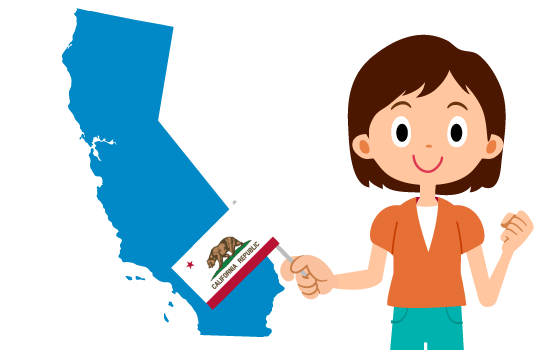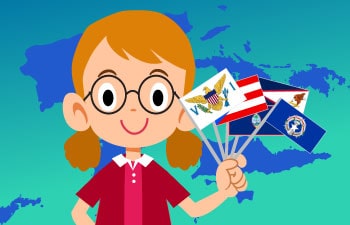Home to world-famous technology companies, bustling metropolitan areas, movie stars and popular tourist attractions, it’s no wonder that California is a global innovator and trendsetter in a number of fields.
Boasting over 1,000 miles of coastline on the pacific, California is the third largest state in the country. In addition to its seashores, the state is also home to a diverse geography that includes forests, deserts, farms, and snow-capped mountains.
This dedicated unit study supplement is part of Time4Learning’s full series of United States unit study supplements and will teach your child facts about the history and geography of the Golden State. Learn more about California’s rich history, diverse physical features, and more. You’ll also find field trip ideas in the state, including freebies that your family can take advantage of, whether you are a homeschooler in California or visitor. You can also download our list of PreK-12 interactive activities that align with your study of interesting facts about California.
California Fast Facts
| Became a State | September 9, 1850 |
|---|---|
| Order it Joined the Union | 31st state |
| State Capital | Sacramento |
| State Abbreviation | CA |
| Border States |
|
| State Flag |  |
| State Song |
|
| State Flower | California Poppy |
| State Nicknames |
|
| Notable Californians |
|
Historical Facts About California
As with many other states, a number of Native American tribes were the first people to call California home thousands of years ago. In 1542, the first Europeans started to arrive. Explorer Sir Francis Drake reached the Golden State in 1579 and claimed the land for England. However, due to its distance from Europe, settlement in the state didn’t begin until several hundred years later.
With the hopes of converting the Native Americans to Catholicism, the Spanish began building missions in California during the 18th century. Totaling 21 missions altogether between 1769 and 1833, the first began in San Diego with the last one located in San Francisco.
In 1821, California became a province of Mexico after the country gained its independence from Spain. Many settlers were against Mexican rule and in 1846, John Fremont led a revolt and declared that California was an independent country which they called the Bear Flag Republic. That same year, the U.S. and Mexico fought in the Mexican-American War. When the war ended in 1848, the state became a territory of the U.S., then two years later, it was admitted as the 31st state.
Around that same time, gold was discovered at Sutter’s Mill about 36 miles northeast of Sacramento. This discovery led to a mass migration of more than 300,000 people between 1848 and 1855.
The name California is believed to come from a mythical island of the same name mentioned in the novel “The Adventures of Esplandian” where Queen Calafia lived. In the book, the island was rich in gold, which, coincidentally, is one of the things California is known for. This, and the expansive fields of yellow (gold) poppies that bloom in the spring, is one of the reasons that California was officially nicknamed the Golden State in 1968.
To increase your child’s love for online learning, they can quickly glance at more historical facts about California with this timeline that highlights important dates as well as interesting facts about the Golden State.
1542
Juan Rodriguez Cabrillo, the first European to visit the state, arrives to the coast of California.
1579
Sir Francis Drake arrives near San Francisco and claims the land for England.
1769
The Spanish build 21 total missions along the coast of California in an effort to convert natives to Catholicism.
1781
The city of Los Angeles is established.
1821
California becomes part of Mexico.
1846
California declares independence from Mexico.
1848
The California Gold Rush begins, drawing 300,000 people to the area.
1849
San Jose is declared the first capital of California.
1850
California becomes the 31st state through the Compromise of 1850 which admitted it into the Union as a free state.
1854
Sacramento becomes the state capital.
1879
Sacramento is named the permanent capital.
1906
A 7.9 magnitude earthquake struck San Francisco on April 18. The death toll is not certain, but reports estimate between 700-3,000.
1928
The St. Francis Dam, near present-day Santa Clarita, collapsed and the resulting flood killed approximately 430 people.
1933
Construction of the Golden Gate Bridge begins.
1937
Golden Gate Bridge opens to traffic.
1955
Disneyland opens in Anaheim in Southern California.
1966
Ronald Reagan was elected governor of California.
1989
An earthquake struck during game three of the World Series in San Francisco. With a magnitude of 6.9, the Loma Prieta earthquake killed 63 people and injured over 3,700.
Bring history and geography to life with Time4Learning’s interactive online social studies curriculum for grades 2-12.
Geographical Facts About California
California is on the west coast of the U.S. It is bordered by Oregon, Nevada, and Arizona. The Golden State ranks first in the U.S. in population with an estimated 39.5 million residents. In area, it ranks third with more than 163,000 square miles. Los Angeles, Spanish for ‘the angels’, is the largest city in the state and the second largest in the country, after New York City. The state is made up of 58 counties.
To help your child become familiar with California, use this printable U.S. map and have him or her try to locate the state. This detailed map of the state will then help your child locate important cities and landmarks, and develop an understanding for its geography.
- California’s Death Valley located half way southeast of the state, and bordering Nevada is North America’s hottest desert.
- Both the highest point and lowest point in the contiguous United States are located in California within 100 miles from one another. Mount Whitney at 14,505 ft above sea level and Badwater Basin in Death Valley at 282 ft below sea level.
- The highest point, Mount Whitney is located in the eastern central portion of the state within the Sierra Nevada mountain range.
Sequoia National Park (90 miles west of Death Valley), is home to the world’s biggest tree. A giant sequoia tree bigger than a basketball court and believed to be over 2,700 years old. - The San Andreas Fault, a crack in the Earth’s crust, extends approximately 750 miles through California from northwest to mid southwest to the Mexican border.
- California is located within the Ring of Fire, a 25,000 mile area that includes over 450 volcanoes, and is known for its active seismic activity. The Ring of Fire runs along South America’s west coast near Chile in a u-shaped pattern up through North America, along Japan and the Philippines, then down near New Zealand.
- The Mojave Desert on the southeastern part of the state, is the driest and smallest desert in North America. It receives less than two inches of rain a year, and covers 50,000 square miles.
- Mount Shasta is a volcano located in north-central California. It last erupted in 1786.
- Los Angeles, the cradle of the film industry and the second most populous city in the nation, is located on the southwest coast of the state. It is 220 miles north of the Mexican border.
- The Sacramento River is the longest within the state. It starts near Mt. Shasta and flows about 400 miles south.
- Scientists believe that increases in the amount of snowfall in California is tied to the air pollution in China.
- 80% of the world’s almond production comes from California.
California State Map
Download our FREE California state map printable. Use it as a coloring page or use it to plot the state’s geographical features.
Activities for Children in California
Do you homeschool in the state of California? Will you be visiting in the near future? There is a wealth of information that the Golden State has to offer. Students can learn tons of California facts by visiting the state’s seemingly endless attractions, many of which offer free admission. Below are just a few ideas to get you started.
- La Brea Tar Pits (Los Angeles) – Learn facts about the Ice Age and how many prehistoric animals were so well preserved at this excavation site. Visitors can tour the tar pits and museum to view fossils of animals found at the site like the saber-toothed cat, mammoths, and more. Homeschool days are available throughout the year for families.
- Alcatraz Island (San Francisco) – After taking a 15-minute ferry ride on San Francisco Bay, visitors will arrive on ‘the rock’, which was home to a federal prison for 29 years. Families can take a self-guided audio tour around the prison and visit the main cellhouse, dining hall, and more.
- Monterey Bay Aquarium (Monterey) – Located in historic Cannery Row, this nonprofit aquarium first opened in 1984. It’s home to roughly 35,000 animals and exhibits include Tentacles, Kelp Forest, Open Sea, and more. The museum offers a homeschool program as well as other educational opportunities.
- San Diego Zoo (San Diego) – Located in Balboa Park, this zoo is home to more than 3,700 animals including giant pandas, koalas, jaguars, giraffes, and more. A number of educational programs, special experiences, and activities are available for visitors.
- Muir Woods National Monument (Mill Valley) – Walk among giant redwood trees that can grow over 370 feet tall at this park a few miles north of San Francisco. Several education programs and activities are available for students. Families can hike the many trails, take a guided tour, or observe the plants and animals that live here.
California Freebies and Deals for Homeschoolers
- Griffith Observatory (Los Angeles) – Located in Southern California, visitors can look up into the skies through telescopes, explore exhibits, learn during live shows at the planetarium, and more. Use of telescopes as well as admission to the observatory and grounds is free. There is a cost to view shows at the planetarium.
- California State Capitol Museum (Sacramento) – Learn facts about California’s history and the lawmaking process in this historic building that is home to the state’s government. Visitors can take part in guided or self-guided tours, visit the theater to watch interpretive films, and explore the museum’s exhibits.
- Timken Museum of Art (San Diego) – This museum’s collection covers more than 700 years of history and includes paintings, sculptures, and tapestries. First opened to the public in 1965, visitors can explore by taking guided tours free of charge.
- Golden Gate Park (San Francisco) – This urban park is made up of over 1,000 acres. It so large, the park is home to museums, a carousel, an aquarium, several playgrounds, and more. Although there is a fee for certain attractions, entry to the park is free. Visitors can enjoy a picnic near one of the many lakes, walk or bike the numerous paths, and check out the buffalo paddock.
California Learning Games for Children
Have your child learn more California facts while practicing their spelling, sentence writing, and more with the fun learning games below. You can test their knowledge of the state or simply give them additional practice to reinforce what they’ve already learned.












